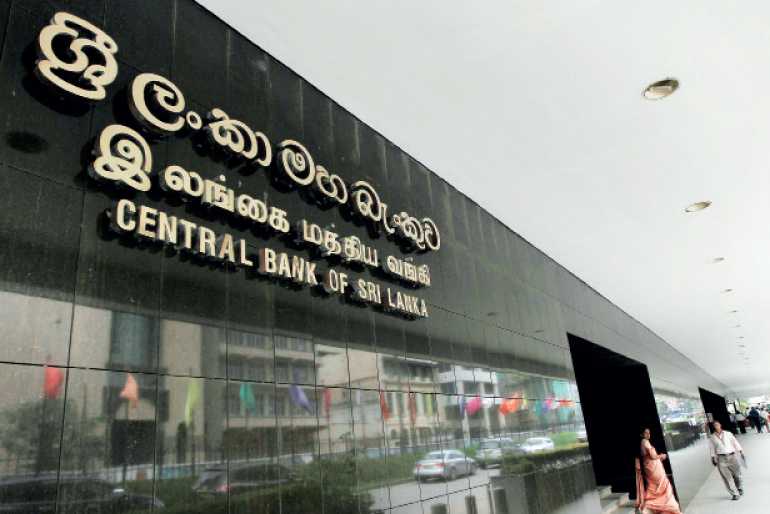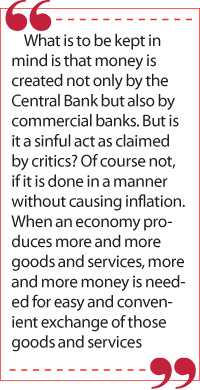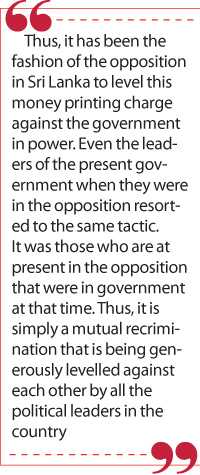Monday Nov 24, 2025
Monday Nov 24, 2025
Monday, 14 September 2020 00:03 - - {{hitsCtrl.values.hits}}

According to ordinary people, money printing is the printing of new currency notes and minting of new coins by the Central Bank. According to opposition leaders who have gone a little farther, money printing constitutes government’s borrowing from the Central Bank by issuing Treasury bills to the Bank
Money printing charge
One of the charges framed against the present government by opposition leaders is that it has printed a lot of money through the Central Bank and made available to people. They believe that such a high volume of money released to people will cause inflation in the future. If inflation is set in the economy, people, especially those in the low-income groups, would suffer. These people would feel that they have become poorer because they could not buy their daily needs with the available income. So, the critics, it appears, have chosen to speak out for the voiceless people. 
Currency boards cannot print excess money
But this charge of money printing can be levelled against all the governments in the country since at least 1950. In that year, the Central Bank was established with powers to print currency at its own discretion and it is this power, which critics say, has been abused by the successive governments. Before 1950, this question would not have arisen because the Currency Board which existed before 1950 could not do so at its discretion.
To issue currency, the Board should have an equal amount of foreign exchange reserves with it, and if there are no such reserves, it cannot issue currency. For instance, suppose a Sterling Pound was equal to a rupee. In that case, for the Currency Board to issue one rupee, it should have acquired one Sterling Pound. Similarly, if it loses one Sterling Pound, say, due to a trade transaction, it has to withdraw one rupee from use.
Hence, before 1950, since currency issue had been restricted by the availability of foreign reserves, governments could not issue new currency to pay their bills. This system of the currency board operations is known as a ‘full or hundred percent reserve system’.
Central banks have discretionary powers to print money
This system was changed when the Central Bank was established in 1950. Since the Bank could issue currency without reference to the availability of foreign reserves – a system called a fractional reserve system – there was no limit to the amount of currency it could issue. Hence, if it did not use its discretionary power responsibly or as the critics have charged, has yielded to the demands of the recalcitrant governments, the economy could have been flooded with new currencies issued by the Bank. The gravity of the problem could be gauged when one refers to a statement made by former President of Zimbabwe, the late Robert Mugabe.
As reported by Time Magazine, when he was asked how he would finance the mega development projects that he had proposed, Mugabe had simply said that ‘If we don’t have funds, we would print money and finance the projects’ Mugabe had referred here to the discretionary currency printing power of his central bank without reference to any criterion. But, as a result of this profligate policy, Zimbabwe’s inflation happened to be the highest in human history at 11 million percent per annum by mid-2008.
Mutual recrimination by politicians
Thus, it has been the fashion of the opposition in Sri Lanka to level this money printing charge against the government in power. Even the leaders of the present government when they were in the opposition resorted to the same tactic. It was those who are at present in the opposition that were in government at that time. Thus, it is simply a mutual recrimination that is being generously levelled against each other by all the political leaders in the country.
Money is created both by the central banks and commercial banks
But what is this money printing? According to ordinary people, money printing is the printing of new currency notes and minting of new coins by the Central Bank. According to opposition leaders who have gone a little farther, money printing constitutes government’s borrowing from the Central Bank by issuing Treasury bills to the Bank. Both these views represent only half the truth. That is because in a modern complex economy, money is the stock of assets which people are having with them to buy goods and services. That stock consists of not only the currency issued by the Central Bank but also the deposits created by commercial banks.
Three components of the money stock
In Sri Lanka as well as in many other countries, that stock has three components. First, the currency issued by the Central Bank and kept by people for their use. Second, the demand deposits, also known as current accounts, which people have with commercial banks. Since payments can be made by writing cheques against those demand deposits, they are as good as the currency issued by the Central Bank. Third component is the savings deposits and fixed deposits which people are having with commercial banks. With modern banking practices facilitated by advancements in technology, these two types of deposits have also become as liquid as demand deposits. People can use them freely when making payments. For instance, suppose you want to buy a car. If you do not have enough cash with you, you can go to your bank and withdraw your fixed deposit subject of course to a small penalty of a reduced interest income. Hence, in a modern economy, all these three components constitute the stock of money, called money supply, that is responsible for influencing the general price level. What we know as inflation is the continuous increase in this general price level for a number of years. 
Money needed to conduct increasing transactions
Therefore, what is to be kept in mind is that money is created not only by the Central Bank but also by commercial banks. But is it a sinful act as claimed by critics? Of course not, if it is done in a manner without causing inflation. When an economy produces more and more goods and services, more and more money is needed for easy and convenient exchange of those goods and services.
Imagine the embarrassment you will have when you get into a bus, if you do not have liquid cash with you to pay the bus fare. You may be the richest man in the country with a lot of possessions like lands, houses, gold and motor cars, etc. But none of them will help you if you are in a bus and if you do not have cash to pay the bus fare. Hence, for the smooth operation of an economy, governments have to allow the money stock or money supply to increase. As long as it does not lead to an increase in the general price level, there is no objection to it.
Responsible money creation
But how could a government do it without causing inflation? We can illustrate it by a simple example. Suppose we have only one commodity, say coconuts, and people have to satisfy all their needs with coconuts. In this economy, what we know as the total output or the Gross Domestic Product or GDP is represented by the number of coconuts. If the coconut production has increased by 100%, we can say that the real GDP too has increased by 100%. Suppose in this economy we have another commodity called money supplied by the Central Bank to facilitate the exchange of coconuts among people. For convenience, let’s call that money rupees or in short Rs.
At the beginning, let’s suppose that people produce 10 coconuts and the Central Bank has supplied Rs. 100. Now, people have to exchange these 10 coconuts for Rs. 100 and the price of a coconut is Rs. 10, arrived at by dividing the stock of money by the number of coconuts. Suppose the production of coconuts increases by 100% to 20. If the Central Bank does not increase money supply, the price of a coconut falls to Rs. 5, a situation known as deflation.
Now, you might think that this price reduction is desirable but it is not so in this case. That is because, the producers whose incomes have fallen below the cost of producing 20 coconuts would reduce coconut production and pretty soon you will not have coconuts to consume. Hence, it is a situation to be avoided by the Central Bank.
What will happen if the Central Bank allows the money stock also to increase by 100% to Rs. 200. In this case, the price of a coconut remains unchanged at a stable level of Rs. 10. Hence, in the economy, Rs. 100 has been newly created but it has not caused inflation to set in. Thus, a government can allow new money in an economy without causing inflation if it limits the new money creation equal to the increase in the real goods and services, commonly known as the real economic growth rate. But what would happen if the Central Bank allows money stocks to go up to Rs. 400? In that case, the price of a coconut also increases to Rs. 20, bringing in inflation to the economic system. Hence, printing of new money per se is not sinful. What is sinful is the printing of money over and above the expanding capacity of the economy, as reflected by the real economic growth rate.
If money printing is sinful, all governments have committed that sin
What this means is that money printing is sinful and the critics are correct if it is done over and above the real economic growth in the country. Unfortunately, this is what has happened during the entirety of the Central Bank era from 1950. From 1950 till end of 2019, the real economy grew by 310%. But the total money stock as we have defined earlier has increased by 706% during this period. Accordingly, the growth in total money stock has far exceeded the growth in the economy.
Fall in the value of money since 1950
That excess money has caused the general price level in the country to increase year after year. For instance, the general price level in 1952 from which year Ceylon, now Sri Lanka, commenced calculating the Colombo Consumers’ Price Index or CCPI was 100. Though the base and the coverage of CCPI has changed over the years, if we prorate it to the original base, the general price level as at end of August 2020 amounted to 11,900. What this means is that a rupee in 1952 is worth only less than a cent at end-August 2020.
If citizens are to be restored to the same welfare level which they had enjoyed in 1952, their income should increase at least by 12,000 times. Since this has not happened, the average man has surely become poorer than before. But all the governments that had been in power should bear responsibility for spreading this ‘inflation-driven poverty’ among the people.
The track record of the present Government
During the first seven months of 2020, the total money stock in the hands of people has increased by Rs. 883 billion. This is the amount of money – at 12% so far in 2020 and 16% over the stock a year ago – printed during the reign of this government as claimed by the opposition leaders. But what has contributed to this increase?
Net foreign assets have fallen
The change in the money stock takes place due to two important changes within the banking system that is made up of both the Central Bank and commercial banks. One is the acquisition of foreign exchange by the system on a net basis, that is, foreign exchange holdings free of any foreign exchange commitments. We can illustrate this with an example.
Suppose an exporter of tea earns one dollar by exporting his merchandise. When he sells this dollar to a commercial bank, the relevant bank would give the equivalent of the dollar in rupees, say Rs. 200, to the exporter and add a dollar to its foreign exchange holdings. But it will not happen if a bank borrows one dollar from abroad because it will increase both the foreign exchange holdings and foreign exchange commitments by the same amount. Hence, the stock of money in the hands of people will increase if the banking system has acquired foreign exchange on a net basis.
But during the first seven months of 2020, the net foreign exchange holdings of the banking system has declined by Rs. 130 billion or six and a half lakhs of US dollars. To that extent, the total stock of money in the hands of people has moved out of the country.
Government borrowings from banking system have surged
The other factor responsible for the change in the money stock is the amount of credit extended by the banking system during the period. In Sri Lanka, there are basically three parties that borrow from the banking system. The first party is the government which borrows from the Central Bank as well as from commercial banks. During the first seven months of the year, the government has borrowed from these two sources, on a net basis, a staggering Rs. 1,400 billion.
The government had to borrow this high volume of money because of the decline in its revenue. Revenue has declined due to the generous tax concessions granted to both income tax payers and VAT payers and the abolition of certain ancillary taxes that had been levied on businesses in the past. Though they are desirable from the point of simplifying the country’s tax system and getting more taxpayers to the tax net in the medium to long run, they have caused a massive drop in the revenue immediately.
It has been estimated that during 2020, the loss of tax revenue will be about Rs. 600 billion. To compensate for this loss, the government was forced to borrow from the banking system.
Public corporations too have increased bank borrowings
The other type of the borrower is government corporations. They borrow from commercial banks to finance shortages in cash flows and losses. During the first seven months of 2020, government corporations have borrowed Rs. 500 billion. When taken together, the total of the public sector borrowings had been Rs. 1,900 billion in the first seven months of 2020. This is lion’s share in total bank credit in the country.
Private sector has used credit sparingly
In contrast, the borrowings by the private sector, made up of companies and individuals, had been only Rs. 454 billion though they account for about 80% of the total output in the country. As a result, the public sector has mainly been responsible for the increase in the total money stock during the first seven months of 2020. This increase will not cause inflation if it corresponds to the real economic growth in the country. But during 2020, economic growth is expected to be negative between 4-6%, according to the estimates presently available. Hence, the entirety of the increase in the money stock could be branded as excessive money. The danger with such increases in the money stock is the increase in inflationary pressures in the coming months.
This possibility could be avoided if a program to increase revenue and reduce bank borrowings is put in place immediately.
(The writer, a former Deputy Governor of the Central Bank of Sri Lanka, could be reached at [email protected].)